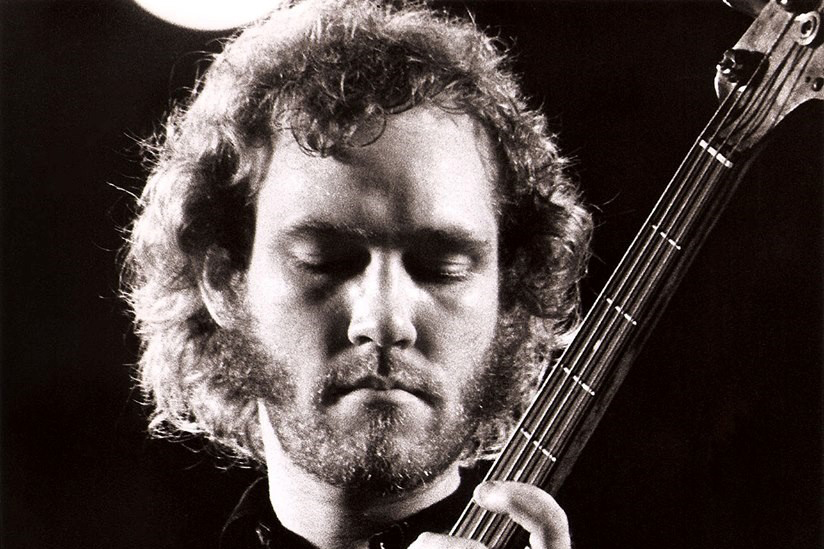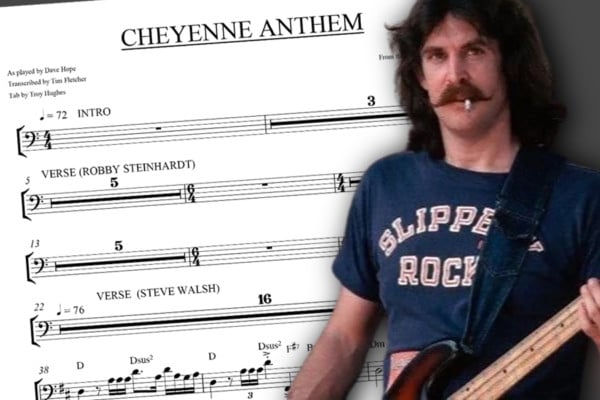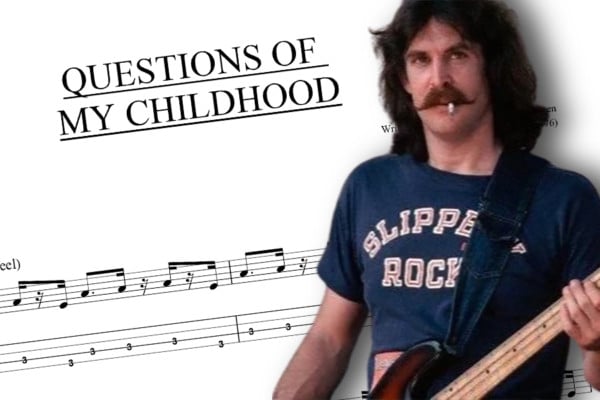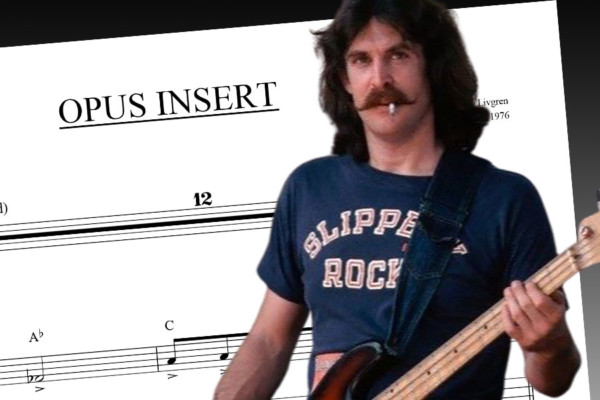Bass Transcription: Doug Haywood’s Bass Line on “Late for the Sky” by Jackson Browne

This song is well-known from its use in the iconic Martin Scorsese film ‘Taxi Driver’, but I first heard it back in the early 90s on a compilation album from artists who had appeared on the BBCtv music show ‘The Old Grey Whistle Test’. I had just gone through a break-up and was sleeping on a friend’s sofa. After they’d gone to work one day, I found myself looking through their CD collection and came across the ‘Best of the Whistle Test’ compilation. Most of the artists on the album were from the 1970s that I knew of already, but I had never really taken any interest in Jackson Browne. By the time that ‘Late for the Sky’ was over, I was amazed to find myself in tears – the lyrics seemed to sum up my situation perfectly, and it also helped to put it in some perspective.
Although Browne’s lyrics and the exquisite guitar playing of David Lindley had been the thing that first attracted me to the song, I hadn’t taken much notice of the bass-line. When I found myself listening to it again recently, I became aware of the subtle and tasteful bass playing it contains. The bassist was Doug Haywood (who describes himself as “the most famous musician nobody’s heard of”) and he appeared on many of Browne’s albums in the 1970s as either bassist, backing vocalist or keyboard player.
Haywood was born in St Louis, MO in January 1950, and as a child, he was a big fan of the Everly Brothers. He persuaded his brothers into a singing group to recreate their hits, but used rather ‘hands on’ methods to make sure that the parts were sung correctly. Haywood also played the clarinet in his high school marching band, but hearing The Beatles for the first time convinced him that he should release his brothers from their singing duties, as he realized that “the world could be a beautiful place even your brothers didn’t sing their parts right.”
Doug Haywood first played guitar at the age of fifteen, and by sixteen he was proficient enough to play in country, folk and bluegrass venues around Phoenix, AZ. Unfortunately, his home life was abusive, and he applied to the courts to gain emancipation from his father. The money he was earning by playing regular gigs in the local coffee houses was sufficient to persuade them that he had the means to support himself outside the home. Haywood also began his bass playing journey around this time, when he told a friend that he could play better than the bassist in their band. Although he had never really played bass, and didn’t own one, he was hired. Once he had acquired a bass it was clear that he had found an instrument that he had a natural inclination for.
When he was eighteen, he joined a trio with vocalist/guitarist Beth Fitchet and multi-instrumentalist Jeff Gilkinson, and they moved to Los Angeles to be closer to the music scene growing there. Haywood’s bass playing ability and harmony vocal talents were quickly recognized, and soon he was playing six nights a week with the local singers and songwriters. This intense period of work was a formative one, as many of the connections that were to drive his career were made at this time.
His band-mate Beth Fitchet had become a fan of Jackson Browne’s song-writing talent and encouraged Haywood to listen to his songs. Browne was a regular at The Troubadour in West Hollywood, and when Fitchet’s trio landed a Monday night gig there, it led to Haywood and Browne making contact. Although he wasn’t initially impressed with Browne’s vocal talents, Haywood recalls that; “He played several of his songs for me and I was hooked. Here was someone with his own way of writing. I knew that he could be popular with a lot of people” Although not immediately fruitful, this connection was soon to become a defining part of his life.
Haywood’s songwriting career also began during this period, when he was asked to play a folk singer in a scene in the US TV drama ‘The Mod Squad’. He chose to play one of his own compositions ‘Don’t Lead Me On’, and this gained him access to a wider audience, and membership of ASCAP. The song was later covered by The Dillards, Mason Williams, and Jennifer Warnes.
In 1970, he joined Phoenix-based country rock band Goose Creek Symphony, and their early successes included appearing on The Ed Sullivan Show with Bobbie Gentry, and shared the stage with Jimi Hendrix and The Allman Brothers Band at the 1970 Atlanta Pop Festival. Haywood played on the second GCS album ‘Welcome to Goose Creek’ (1971) and then joined Bobbie Gentry’s backing group, staying for two years. He eventually followed two of his former bandmates from Goose Creek Symphony into Linda Ronstadt’s band.
The connection with Browne eventually paid off when Browne’s guitarist David Lindley recommended Doug for the bass player’s role on Browne’s second album ‘For Everyman’ (1973). He would record and tour with Browne for the next twenty years, providing bass, keyboards and backing vocals on many of his albums.
Apart from his work with Jackson Browne, Haywood has also sung or played with by Willie Nelson, George Harrison, Warren Zevon, Bonnie Raitt, Elton John, Linda Ronstadt, Graham Nash, and James Taylor. He has also opened (as a solo artist) for Little Feat, the Nitty Gritty Dirt Band, Joan Baez, Emmy Lou Harris, Jerry Garcia, and many others. His songs have been recorded artists such as Jerry Reed, John Travolta, Beth Fitchet-Wood, David Lindley.
Doug Haywood is currently living back in Phoenix, and although he does not play on studio sessions anymore, he still performs occasionally, sometimes with his son Aaron.
Late for The Sky
The bass-line starts with a simple approach mainly built from longer notes, with some subtle slides in places, and this continues through the first verse. In the first pre-chorus, Haywood adds in a few more notes and slightly more complex rhythms but returns to a simpler line in verse two, although there is a little more variation in rhythm this time. The first full chorus at bar 58 contains a little more melodic flow in places, and a nice octave and fourth idea to match the chord inversion through bars 63 to 65.
During the guitar solo there is again a little more rhythmic movement, and Haywood uses some more melodic, scalar ideas in bars 81-2. The next pre-chorus and chorus return to a simpler approach, but these contain a few short, scale-based links in places, and the return of the octave and fourth idea at bar 98. The outro, from bar 104 onwards, contains a much more melodic approach, with the root notes being interspersed with inventive high range melodic fills that weave around David Lindley’s sinuous guitar lines.
The bass-line is a masterclass in taste and restraint, and Haywood is not afraid to keep the line simple and unobtrusive but remaining supportive throughout. The high-range bass melodies near the end of the track are unexpected and add a more positive, uplifting feel to a rather down-beat song. Haywood’s vocal harmonies are also a delight, meshing beautifully with Browne’s vocal, and adding warmth and color to the song.
The basic tracks for the song were recorded live in one take, and Haywood’s tone on the track is a delight – soft and unobtrusive throughout and is probably played on a Fender Jazz. Aaron Haywood suggests that his father recorded the song using either an Ampeg flip-top 15” amplifier or direct to the desk, but Doug insisted that his signal was not run through a limiter.
Download the transcription and follow along with this video:


